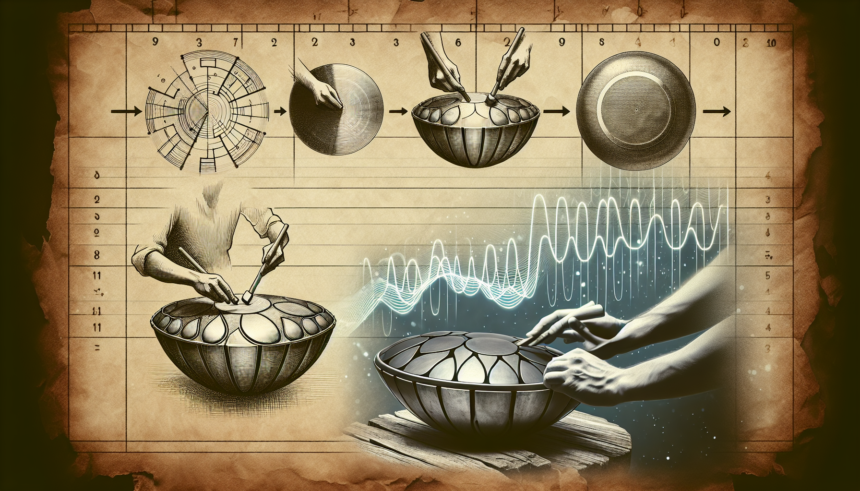<!DOCTYPE html>
<html lang="en">
<head>
<meta charset="UTF-8">
<meta name="viewport" content="width=device-width, initial-scale=1.0">
<title>The Evolution of Handpan Notes: From Concept to Sound</title>
</head>
<body>
<p>
The world of musical instruments has always been vibrant and diverse, featuring everything from intricate strings to booming percussion. Among these instruments, the handpan has emerged as a unique and mystifying member of the percussion family. Its enchanting sound captivates audiences and musicians alike. However, understanding the evolution of its notes, from initial concept to the creation of mesmerizing melodies, requires a closer look at its history, craftsmanship, and the creative minds that brought this instrument to life.
</p>
<h2>Origins and Early Development</h2>
<p>
The handpan is a relatively new addition to the pantheon of musical instruments, having first made its appearance in the early 2000s. Its predecessor, the Hang, was created by Felix Rohner and Sabina Schärer of PANArt, a Swiss company. Their work was inspired by various instruments, including the steelpan from Trinidad and Tobago and other idiophones. The aim was to create an instrument that encapsulated the rich resonant qualities similar to the Ghatam, Udu, and others. The evolution of the handpan notes began with a harmonic principle where each note had multiple overtones, a groundbreaking concept in its construction.
</p>
<h2>The Craftsmanship of Handpan Tuning</h2>
<p>
Crafting a handpan is an intricate task that demands a harmonious blend of art and science. The process begins with selecting high-quality steel or nitrided steel, which is then expertly sculpted into two halves – one for the note field (top side) and another for the resonant cavity (bottom side). The note field features several dimpled areas which form the notes. Each note is meticulously hammered and tuned to resonate at specific frequencies, including a fundamental tone and several harmonic overtones. This unique tuning is what gives the handpan its ethereal sound.
</p>
<p>
Over the years, as craftsmanship techniques have evolved, so has the precision of the notes created. Earlier models had some limitations in terms of range and clarity, but modern handpans showcase expansive tunings like Kurd, Hijaz, Celtic minor, and many others that cater to diverse musical genres and preferences. Tuners continuously refine their techniques, using tools from traditional hammers to advanced tuning software, to achieve the desired sonic perfection.
</p>
<h2>Exploration of Musical Styles</h2>
<p>
The handpan's journey from concept to sound is not just a technical narrative but a creative one. Musicians and composers have pushed the boundaries of what can be achieved with this instrument. Its melodic, rhythmical, and harmonic capabilities make it versatile enough to fit a wide array of musical contexts. From traditional folk songs to contemporary ambient music, and even experimental electronic music, the handpan lends a mystical aura to any composition.
</p>
<p>
Musicians around the world adopt different approaches to playing the handpan. Some prefer the meditative, soothing sounds that the instrument can produce, allowing listeners to experience calming and introspective sessions. Others might integrate the handpan with more vibrant musical settings, using it to complement instruments like the guitar, violin, or flute. This flexibility is largely due to the evolution of the notes over time, enabling players to explore various scales and styles.
</p>
<h2>The Role of Technology</h2>
<p>
As technology has advanced, so too has the development and evolution of the handpan's notes. Digital sound engineering and advanced acoustic analysis have provided tuners with tools that were once unimaginable. High-precision frequency analyzers allow for meticulous monitoring of each note's harmonics, ensuring they resonate perfectly. Innovative sound modeling software aids in predicting how new note configurations might behave acoustically even before the handpan is physically built.
</p>
<p>
Besides traditional handpan craftsmanship, there have been experiments with electronic handpans and virtual instruments that mimic the acoustic properties of the real handpan. This digital evolution allows musicians to incorporate the characteristic sound of the handpan into their music without needing the physical instrument, expanding its reach and influence in the modern music era.
</p>
<h2>Conclusion</h2>
<p>
The evolution of handpan notes from concept to sound represents a fascinating journey through art, science, and the passionate pursuit of musical expression. From its humble beginnings as the Hang to becoming one of the most cherished instruments in the modern world, the handpan continues to captivate audiences with its otherworldly tones. Through continuous innovation and creativity, musicians and tuners alike push the boundaries of what is possible, ensuring the handpan's sound remains as mystifying as ever.
</p>
<h2>FAQs</h2>
<h3>1. What is the origin of the handpan?</h3>
<p>
The handpan was developed from the Hang, created by Felix Rohner and Sabina Schärer of PANArt, in the early 2000s. The design was inspired by a mix of traditional steelpan instruments and other resonant idiophones.
</p>
<h3>2. How are handpan notes tuned?</h3>
<p>
Handpan notes are meticulously crafted by tuning the steel shell to resonate at specific frequencies, including a fundamental note and a series of harmonics. This is done through skilled hammer work and sometimes aided by tuning software for precision.
</p>
<h3>3. What scales can be played on a handpan?</h3>
<p>
Handpans can be tuned to various scales, such as Kurd, Hijaz, Celtic minor, and others. The choice of scale affects the mood and suitability for different musical styles.
</p>
<h3>4. Can technology enhance handpan crafting?</h3>
<p>
Yes, technological advancements in sound engineering and acoustic analysis have significantly aided in the precision tuning of handpans, ensuring high-quality sound production and expanded note configurations.
</p>
<h3>5. Are there electronic versions of the handpan?</h3>
<p>
Yes, there are electronic handpans and virtual instruments that replicate the sound of traditional handpans. These allow musicians greater flexibility and accessibility to the instrument's unique tonal qualities without needing the physical model.
</p>
</body>
</html>The Evolution of Handpan Notes: From Concept to Sound

Leave a comment




